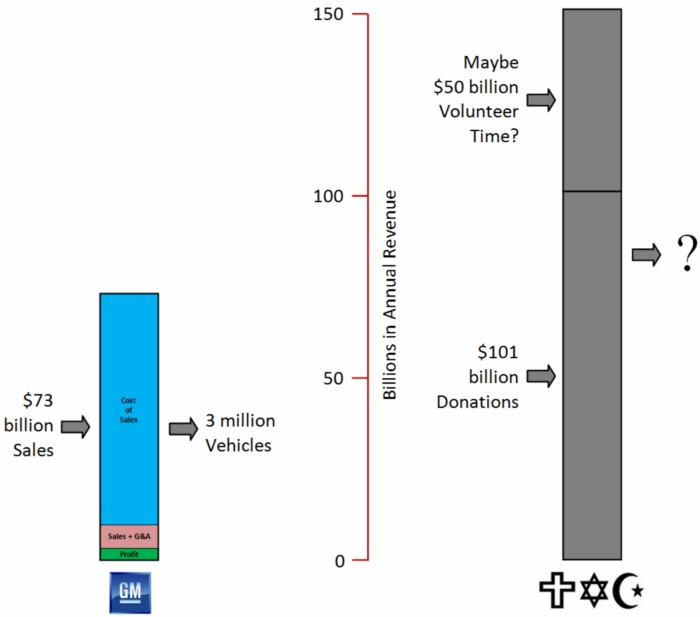Religion is a hugely costly machine, but what does it produce? Let’s compare religion to a big corporation since we know how those work.

Take General Motors (on the left of the red revenue scale in the figure above). In 2010, U.S. sales were $73 billion, and that bought three million vehicles. Pretty simple—$73 billion goes in and three million vehicles comes out.
We can peek inside to see where the money goes. Of the incoming revenue, 87% went to automotive cost of sales—manufacturing and materials purchasing. Next, 8% to sales/marketing and G&A (General and Administrative)—the cost to sell the vehicles plus overhead. The final 5% was profit.
Compare this to religion (on the right side of the revenue scale above). In the U.S. for the same year, donations to religion were $101 billion. But that isn’t the only input. Few GM employees spend their free time selling or manufacturing cars, no matter how much they love the company, but religious believers do the equivalent all the time. They volunteer in all sorts of ways for the benefit of religion: evangelizing, serving as deacon or pianist, doing repairs on the church structure, making food for potlucks and bake sales, and so on. How much is this worth? Multiply by a couple hundred million American Christians and we get an extra 50% of income (a very rough guess).
Where does the church’s income go? We don’t know for sure. The IRS grants tax-exempt status to qualified organizations in return for those organizations opening their books to show the public how they spent their money … except for churches and ministries. All we know is that every year about $100 billion (plus a lot of volunteer effort) goes into a black box.
Obviously, personnel must be a huge cost—there are roughly 600,000 paid clergy in the U.S. Buildings, land, and other capital outlays are another biggie—megachurches don’t just build themselves.
So, what’s the output? This black box gets twice the input of GM; what’s religion’s equivalent of six million vehicles?
Nothing goes back to society through taxes. Maybe 10% passes through to good works outside the church. (Again, this is just a guess since churches’ books are closed.) Maintenance of the congregation is another expense, and to some extent this is worthwhile—helping those in need and providing a community for the members.
The rest is the church’s equivalent of marketing—recruiting new members and keeping current members within the fold. General Motors knows that customers of Buick and GMC vehicles won’t remain customers without ongoing marketing, and churches know the same.
And maybe that’s the best way to see religion. Religion is a very inefficient route to charitable giving (imagine a charity with 90% overhead), and religion isn’t necessary to get the social benefit of community. Those benefits could be provided without the inefficient machinery of the church. Religion must be propped up with marketing as is done with Chevy and Cadillac (with an imaginative dose of fire and brimstone thrown in) to remind customers that they’ve backed the right horse.
GM doesn’t need faith to stay in business, but it’s the only thing keeping religion going.
Inspiration credit: Richard Russell suggested this comparison.
Related posts:
